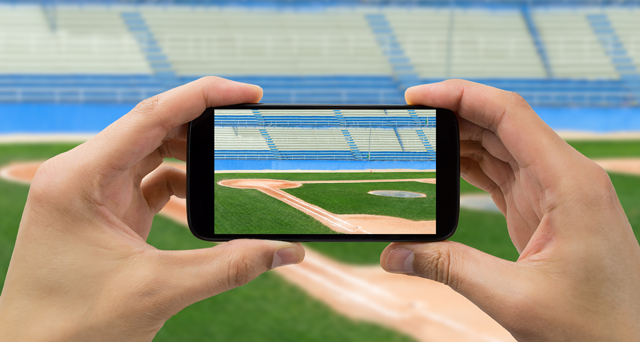Updated 6/11/24
What better way to celebrate this Father’s Day than to take part in one of America’s favorite pastimes – a baseball game. The atmosphere can’t be beat: spirited fans, peanuts, Cracker Jacks, and STEM. Wait, STEM?
Yep, science, technology, engineering, and math are most certainly found at your nearest baseball diamond. Physics, engineering, and statistics all help bring that ball game to life. Let’s use a few of the major elements of the game to break down a few of the STEM connections.
The Pitch
The perfect pitch is certainly produced by talent, but it’s absolutely affected by physics. There are three forces that determine whether the pitch that slides across the plate is a fastball or a curveball:
- Gravity – The force that pulls the ball toward the ground.
- Drag – The force that slows the ball down.
- Lift – The aerodynamic force that moves the ball through the air and is counter to gravity. Specifically, at play is the Magnus force or Magnus effect, which results from the grip and wrist spin a player uses. As the ball spins through the air, the pressure varies and produces a force perpendicular to the motion of the ball, based on the direction of the spin. A pitcher can make the ball rise, slow, drop, or curve all by holding the ball in different positions, creating more or less drag and lift.
But, even more can be observed during pitching.
Sequential Summation of Movement
A biomechanical principle transferring momentum from the pitcher’s body to the baseball. The pitcher’s form and momentum have a role in the performance of the pitch. A pitcher transfers his weight from his legs and hips up through his body to his wrists and fingers via a range of motions such as rocking, pivoting, rotating, and the final delivery.
Speed of Pitch
The speed of a pitch is calculated by dividing distance traveled by the time it took to travel (S=D/T). To convert the speed in feet per second to miles per hour, you must take it one step further and multiply it by 0.682 (which is the seconds per hour divided by feet per mile – 3,600 / 5,280).
The Baseball Bat
The bat isn’t only an example of basic science and engineering principles on its own but is also used to display many others.
Simple Machine
It’s a big stick but also a simple machine, a lever. Specifically, it's a third-class lever, which means that the effort (force) is between the fulcrum and the resistance. The heaviest part of the bat, toward the top, is the resistance, while the fulcrum is at the other end of the bat.
Material
Generally, bats are wide at the barrel and narrow at the handle, with varying widths and lengths; the exact measurements vary, as do the materials.
Aluminum bats are hollow and light, with bigger barrels, allowing a batter to send a baseball to the fences. Aluminum bats also create the trampoline effect, essentially an almost elastic-type energy that is caused by the bat absorbing some of the energy, creating extra force to send the ball farther and faster. Read about the reason aluminum bats aren’t allowed in the MLB.
Wooden bats are used in professional baseball as they have been since the game started. They’re made from one piece of solid wood, such as ash, maple, and birch, and at one time even hickory. The composition of the wood, whether it’s ring porous like ash or diffuse porous like maple, makes a difference in not only the weight of the bat but also its strength and durability. It’s common for wooden bats to break or splinter – the extent to which they do so is based on what they’re made of and where force is applied. It’s been proven that wooden bats produce lower batted-ball speeds.
The Sweet Spot
Finding the sweet spot on a bat produces a better hit. This spot is where the impact of the ball causes the least vibrations and the least impact is felt by the batter. The sweet spot is located between two vibrational nodes and produces the maximum batted-ball speed and the maximum energy transferred to the ball.
The Stats
Baseball is a numbers game. A few of the standard stats typically tracked are:
- Score – The most basic number that matters in the game calculated by counting the total runs scored by each team
- Batting Average – The batter’s number of hits divided by the number of at bats. The general average in the major leagues is .250-.275, with .300 being a very good average.
- Earned Run Average (ERA) – The calculation of how many runs a pitcher allows in nine innings as compared to the overall number of innings pitched. To figure, multiply the number of allowed runs by nine innings and then divide that total by the number of innings pitched. It’s preferred that the number be kept as low as possible.
- On-Base Percentage – This is similar to a batting average but includes at bats that led to walks and any times a hitter was hit by a pitch. Add base hits, bases on balls, and hit-by-pitches and then divide by the sum of at bats, bases on balls, hit-by-pitches, and sacrifices.

The Technology
Baseball has a long history of tradition, but it also has made a great effort to continually evolve with the times. The incorporation of technology is changing the players’ experiences in recruiting to the sport, in training, and on the field. It’s also expanding the game to new generations while working to enhance the experience for current and lifetime fans.
Fan Experience
The fan experience is way beyond your seat in the stadium. There are apps that help you track player and team statistics. There are fantasy leagues instead of just baseball cards. There are even virtual reality glasses at some ballparks that allow you to be immersed in the experience – even out in the outfield.
Training and Practice
Recording, measuring, and analyzing training efforts are helping players improve their individual performance as well as helping teams assess their strengths and areas to improve. There are systems that track eye movement, swings, pitches, plays, nutrition, and more.
Tablets/Devices/Internet Access
Many coaches, scouts, and reporters are now using devices to track players, plays, and other game information instead of their once-trusty notebooks. Plus, fans can easily and instantaneously share their experiences at the games or stream a game from anywhere in the world.
Pace of Play and Reviews
For better or worse, depending on who you ask, how the game is played and the calls that are made are also influenced by technology. There’s now a pitching clock to help keep pace of the game. Video has been used since 2002 to track pitches. Replays of footage to dispute plays are also now allowed.
Safety Gear
Advancements in producing better, more innovative materials are allowing more practical and protective safety gear to be created and implemented. For example, there are now carbon fiber- and Kevlar-lined helmets helping to keep pitchers safer from balls being hit back at them.

There are many more STEM connections that can be made with America’s game. If you’re near a ballpark, take dear ol’ dad out to the ball game. Grab a spot in the cheap seats, snag a hot dog, root for the home team, and watch some science and math right before your eyes.
Ah, baseball, dads, and STEM . . . sounds like a home run to us.
MORE RESOURCES:
- STEM Education – baseball-themed STEM lessons
- Baseball STEM on Pinterest
- Teaming up with STEM: How sports and learning connect
- USAEL Pathway Esports Grades 6-12

